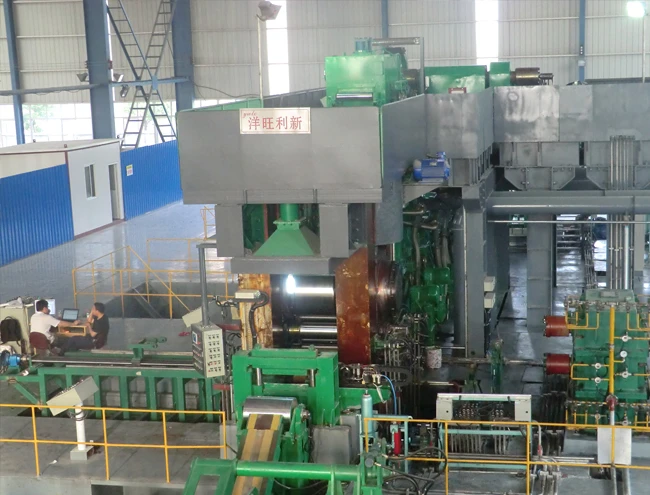
Cladding Rolling Mill - YWLX | Cold Rolling Cladding Technology, Energy-Efficient Metal Bonding
YWLX (Beijing Yang Wang Li Xin Sci&Tech Co., Ltd.) has pioneered a groundbreaking cladding rolling mill that redefines the standards of metal bonding in modern manufacturing. This innovative solution leverages cold rolling technology to produce high-quality bimetallic and trilayer metal strips, addressing long-standing challenges in surface quality, energy efficiency, and production cost. Below, we explore the technical features, advantages, and applications of this cutting-edge technology, supported by authoritative insights from the National Institute of Standards and Technology (NIST).
Technical Features of the Cladding Rolling Mill
The cladding rolling mill developed by YWLX employs a cold rolling process that eliminates the need for acid pickling treatment, resulting in excellent surface quality. Unlike traditional hot rolling methods, which leave oxides on the strip surface, cold rolling ensures a clean, oxide-free finish. This not only enhances the aesthetic appeal of the final product but also reduces post-processing steps, saving time and resources.

Another key technical feature is the energy conservation and environmental protection aspect. By avoiding reheating before rolling and eliminating acid pickling after rolling, the process aligns with global sustainability goals. This reduces energy consumption and minimizes chemical waste, making it a preferred choice for eco-conscious manufacturers. According to NIST, energy-efficient technologies are critical for reducing industrial carbon footprints, and YWLX's solution exemplifies this principle [1].
Streamlined Production Process
The cladding rolling process is simplified into three main stages: surface treatment before rolling, bonding rolling, and annealing treatment. This streamlined approach ensures a high yield rate (above 90%) and significantly lowers production costs. The system's efficiency is further enhanced by its ability to bond bimetallic or trilayer metals in a single production line, offering versatility for various industrial applications.
Advantages of Cold Rolling Cladding Technology
YWLX's cold rolling cladding technology offers several distinct advantages over conventional methods. One of the most notable is the elimination of surface defects caused by oxidation. Traditional hot rolling often results in uneven surfaces, requiring additional treatments. In contrast, the cold rolling process ensures a uniform, high-quality finish that meets stringent industry standards.
Moreover, the low production cost and reduced investment make this technology accessible to a broader range of manufacturers. The high yield rate further contributes to cost-effectiveness, as fewer resources are wasted during production. These benefits are particularly relevant in industries where cost efficiency is paramount, such as automotive and electronics manufacturing.

According to NIST's research on manufacturing standards, technologies that reduce waste and improve yield are essential for sustainable industrial growth. YWLX's cladding rolling mill exemplifies this by combining innovation with practicality, offering a solution that is both economically and environmentally viable.
Applications of Cladding Rolling Mill Technology
The versatility of YWLX's cladding rolling mill makes it suitable for a wide range of industries. In the electronics industry, the technology is used to produce copper-steel and aluminum-steel strips, which are critical for heat dissipation and structural components. The chemical industry benefits from the corrosion-resistant properties of bimetallic strips, while the automotive sector utilizes them for lightweight, durable parts.
Additionally, the decorative materials industry leverages the high surface quality of cladding strips to create aesthetically pleasing finishes. For example, copper-aluminum and stainless steel-steel cladding strips are used in architectural applications, offering both durability and visual appeal. The ability to produce strips with a minimum thickness of 0.2mm further expands the possibilities for precision manufacturing.
Company Background: YWLX's Commitment to Innovation
Founded as YWLX (Beijing Yang Wang Li Xin Sci&Tech Co., Ltd.), the company has established itself as a leader in metal bonding technology. By integrating the latest global advancements in cold rolling cladding, YWLX has developed a comprehensive suite of solutions for bimetallic and trilayer metal production. Their expertise spans multiple materials, including copper, aluminum, and stainless steel, enabling them to cater to diverse industrial needs.
YWLX's commitment to innovation is evident in their ability to bond multiple metals in a single production line. This capability not only enhances efficiency but also reduces the complexity of manufacturing processes. The company's focus on energy conservation and environmental protection aligns with global trends toward sustainable manufacturing, positioning YWLX as a forward-thinking player in the industry.
Product Specifications Table
| Specification | Description |
|---|---|
| Surface Quality | Excellent, oxide-free finish due to cold rolling process |
| Energy Efficiency | Eliminates reheating and acid pickling, reducing energy consumption |
| Production Process | Three-stage process: surface treatment, bonding rolling, annealing |
| Yield Rate | Over 90%, ensuring minimal waste and cost efficiency |
| Material Compatibility | Copper-steel, aluminum-steel, copper-aluminum, aluminum-stainless steel, stainless steel-steel |
| Thickness Range | Minimum thickness of 0.2mm for precision applications |
| Applications | Electronics, chemical industry, automotive, decorative materials |
Conclusion: A Sustainable Future for Metal Bonding
The cladding rolling mill developed by YWLX represents a significant advancement in metal bonding technology. By combining cold rolling with energy-efficient processes, the company has addressed critical challenges in surface quality, production cost, and environmental impact. As industries continue to prioritize sustainability and innovation, YWLX's solutions offer a compelling alternative to traditional methods.
For more information about YWLX's cladding rolling mill and its applications, visit their official website: YWLX Cladding Rolling Mill. Explore their product range and discover how their technology can enhance your manufacturing processes.
References
[1] National Institute of Standards and Technology (NIST). "Driving Innovation." Retrieved from https://www.nist.gov.
-
YWLX’s 1450mm Six-Hi Reversing Mill Goes Live in BangladeshNewsNov.24,2025
-
Adjusting Roll Gap in 6Hi Reversing Cold Rolling Mill for Thin StripNewsNov.13,2025
-
Quality Control Standards for Automatic Gauge Control in Strip RollingNewsNov.13,2025
-
Effect of Skin Pass Rolling on Metal DuctilityNewsNov.13,2025
-
Key Components of a Modern TempermillNewsNov.13,2025
-
Common Wear Patterns of Work Roll in Tandem Cold Mill OperationsNewsNov.13,2025
-
Revolutionary Skin Pass Rolling Technology for Enhanced Steel QualityNewsNov.04,2025










